Related Research Articles

The Colpodea are a class of ciliates, of about 200 species common in freshwater and soil habitats. The body cilia are typically uniform, and are supported by dikinetids of characteristic structure, with cilia on both kinetosomes. The mouth may be apical or ventral, with more or less prominent associated polykinetids. Many are asymmetrical, the cells twisting sideways and then untwisting again prior to division, which often takes place within cysts. Colpoda, a kidney-shaped ciliate common in organic rich conditions, is representative.

Blepharisma is a genus of unicellular ciliate protists found in fresh and salt water. The group includes about 40 accepted species, and many sub-varieties and strains. While species vary considerably in size and shape, most are easily identified by their red or pinkish color, which is caused by granules of the pigment blepharismin.
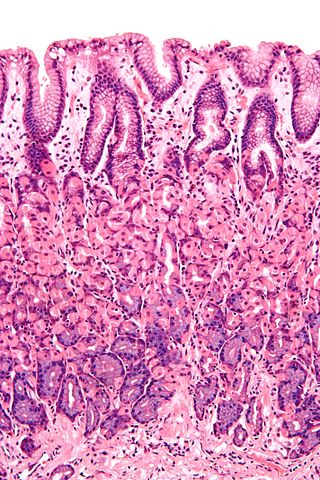
Simple columnar epithelium is a single layer of columnar epithelial cells which are tall and slender with oval-shaped nuclei located in the basal region, attached to the basement membrane. In humans, simple columnar epithelium lines most organs of the digestive tract including the stomach, and intestines. Simple columnar epithelium also lines the uterus.
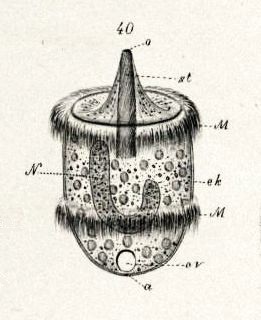
Didinium is a genus of unicellular ciliates with at least ten accepted species. All are free-living carnivores. Most are found in fresh and brackish water, but three marine species are known. Their diet consists largely of Paramecium, although they will also attack and consume other ciliates. Some species, such as D. gargantua, also feeds on non-ciliate protists, including dinoflagellates, cryptomonads, and green algae.

Colpoda is a genus of ciliates in the class Colpodea, order Colpodida, and family Colpodidae.
Karyorelictea is a class of ciliates in the subphylum Postciliodesmatophora. Most species are members of the microbenthos community, that is, microscopic organisms found in the marine interstitial habitat, though one genus, Loxodes, is found in freshwater.
Loxodes is a genus of karyorelictean ciliates, belonging to Loxodidae. It is the only known karyorelictean ciliate that lives in freshwater habitats.
Halofolliculina corallasia is a species of heterotrich ciliates identified as a cause of the syndrome called skeletal eroding band (SEB). It is the first coral disease pathogen that is a protozoan as well as the first known to be a eukaryote; all others identified are bacteria. Like other members of the folliculinid family, H. corallasia is sessile and lives in a "house" called a lorica, into which the cell can retreat when disturbed. The mouth is flanked by a pair of wing-like projections that are fringed with polykinetids, groups of cilia that work in groups to produce a current that draws food into the "mouth".

Katabia is a genus of soil-dwelling heterotrophic flagellate cercozoans containing the single species Katabia gromovi, and the only member of family Katabiidae.

Epixenosomes, also known as Candidatus Epixenosoma, are a genus of bacteria in the phylum Verrucomicrobiota that form a symbiosis with marine ciliates of the genus Euplotidium, where they help to defend their ciliate hosts against predators. It is a monospecific genus, containing only the species Ca. Epixenosoma ejectans.
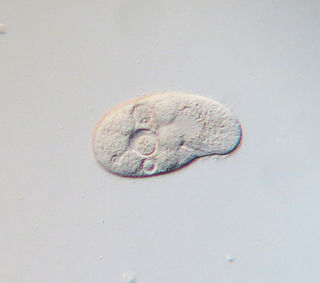
Colpidium colpoda are free-living ciliates commonly found in many freshwater environments including streams, rivers, lakes and ponds across the world. Colpidium colpoda is also frequently found inhabiting wastewater treatment plants. This species is used as an indicator of water quality and waste treatment plant performance.

Kraken is a genus of amoebae within the Cercozoa, containing the sole species Kraken carinae. These amoebae are characterized by a small round cell body and a network of thin and very long filopodia that can reach up to a mm in diameter. Kraken amoebae feed on bacteria and live in freshwater and soil systems.
Platysulcus tardus is an eukaryotic microorganism that was recently discovered to be the earliest diverging lineage of the Heterokont phylogenetic tree. It is the only member of the family Platysulcidae, order Platysulcida and class Platysulcea.
Geleiidae is a family of karyorelict ciliates. It is sometimes synonymized with family Aveliidae.

Zoothamnium niveum is a species of ciliate protozoan which forms feather-shaped colonies in marine coastal environments. The ciliates form a symbiosis with sulfur-oxidizing chemosynthetic bacteria of the species "Candidatus Thiobios zoothamnicoli", which live on the surface of the colonies and give them their unusual white color.
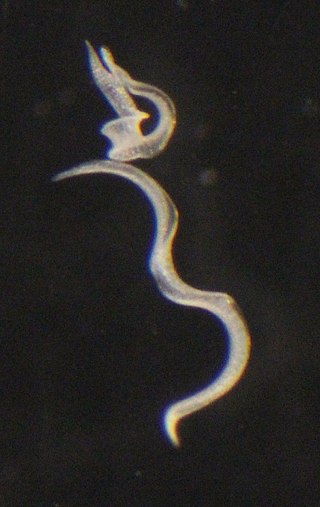
Kentrophoros is a genus of ciliates in the class Karyorelictea. Ciliates in this genus lack a distinct oral apparatus and depend primarily on symbiotic bacteria for their nutrition.

Tracheloraphis is a genus of ciliates in the family Trachelocercidae.
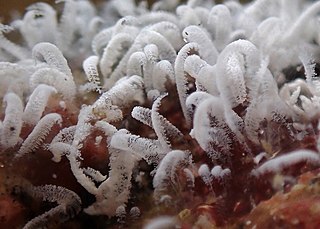
Zoothamnium is a genus of ciliate protozoan.

Halteria, sometimes referred to as the jumping oligotrich, is a genus of common planktonic ciliates that are found in many freshwater environments. Halteria are easy to locate due to their abundance and distinctive behaviour with observations of Halteria potentially dating back to the 17th century and the discovery of microorganisms. Over time more has been established about their morphology and behavior, which has led to many changes in terms of classification.
Diaphanoeca grandis is a species of choanoflagellate in the family Acanthoecidae which is the type species of the genus Diaphanoeca. It is a unicellular micro-heterotroph with a large protective lorica that is found beneath sea ice in a wide distribution. The lorica is composed of silica and possibly originates from diatoms via Horizontal gene transfer.
References
- ↑ Yuan Xu; Jiamei Li; Weibo Song; Alan Warren (6 July 2013). "Phylogeny and establishment of a new ciliate family, Wilbertomorphidae fam. nov. (Ciliophora, Karyorelictea), a highly specialized taxon represented by Wilbertomorpha colpoda gen. nov., spec. nov". Journal of Eukaryotic Microbiology . 60 (5): 480–489. doi:10.1111/JEU.12055. ISSN 1066-5234. PMID 23829190. Wikidata Q30653609.